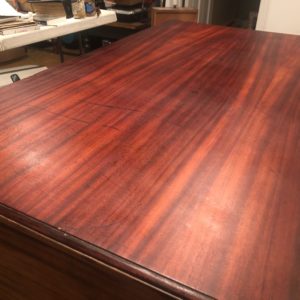For some reason as you can see in the photo, I am getting dull spots and shiny spots in my desk I am french polishing.
I am using a linen rag with equal parts 190 proof alcohol and shellac. I squirt a little of each on wool fibers stuffed in the rag, until it’s damp but not too wet. I then massage the wood in a circular motion, from one end to the other making sure not to miss any spots. I mixed my own and used garnett on the first four coats and planned on using and lemon for the rest.
I’m getting inconsistent results. From what I can tell from watching many tutorials online, I am doing it correctly. Is there a good way to avoid these dull spots, or should this be expected until I build up more coats. What you are seeing is the fifth coat of shellac.
Help much appreciated!
















Replies
Maybe I'm better off airbrushing the shellac on. Doing it by hand on such a large piece of furniture is turning out to be more difficult than I thought. Think I have to sand it off now and redo.
It's possible you have some blushing. It comes from the alcohol flashing off when it's too humid.
Way back in the day I fiddled with French polishing. It seemed . . . sexy, I guess. It's really just a pain in the ass.
To me, the only reason to do French polishing is to incorporate pumice in order to fill the grain. If it's just a way to apply shellac, there are far, far easier ways to apply shellac. And you can still fill the grain, you just need to add more build, and sand after every coat or two.
Shellac sprays wonderfully, if you have a sprayer. You can spray a one pound cut, wait an hour, and spray another. You can easily finish a project in a day. Spray on a coat of waterborne poly as the final coat for a lot more protection, and no one will know it isn't just shellac.
Shellac brushes great too. I brush most of the time. Use a narrow brush, one inch, and you'll have fewer lap marks. If you do get a lap mark or drip, a rag with a little alcohol on it will blend it in really fast.
Are you using a grain filler? If you are not, then you are not french polishing, you are just applying shellace in a way that will make it difficult to get a smooth finish.
The circular application is meant to force the filler into the pores and pack them solidly. Without the filler you are putting the shellac on slowly and in a random pattern that will never have a wet edge.
I would suggest a light sanding with a stiff block and then apply your shellac in a regular manner, either with a brush or pad and in long end-to-end strokes.
I'm certainly no expert, but I have had similar issues the one time I tried polishing on shellac.
Thinking it was caused by unequal application of shellac, what I did was rub out with nothing but alcohol, first in circular motions, then long sweeping motions.
Seemed to do the trick for me, maybe worth a try.
But nowadays I won't apply shellac to a large surface other than by spraying.
Add a little olive oil to your mix, a drop or two to the work surface, and as you get the build going, add more alcohol and less shellac.
The olive oil will add some lubricant and make the rag glide nicer, giving you a better, smoother finish.
I have to ask. Does spraying on shellac work better than rolling it on with a paint roller? Someone told me today that they prefer using a roller, but another person told me that an HVLP gun setup will give you the best results.
I've never heard of using a paint roller. Shellac dries really fast. Using a roller will be very thick, cause runs, and textured surface. It dries so fast, it won't have time to flow out.
Spraying is great, but not everyone can spray. Liquid shellac is extremely flammable, and needs a spray booth, or outdoors.
Most of the time I brush. I use a 1 inch natural bristle brush. Don't use a foam brush. Shellac will dissolve it.
If you are diluting with 50% alcool a liquid shellac you are getting a very thin mixture in your pad and if you are at 5 applications, you really are just getting started with building a finish. My guess is that the tabletop has an uneven texture and will require several passes with a straight full concentration shellac to even out. Then you can start with thinning the pad by adding alcohol only. I use olive oil for cooking mostly, for French polishing I use boiled linseed oil , just a drop on the pad surface as needed.
This forum post is now archived. Commenting has been disabled